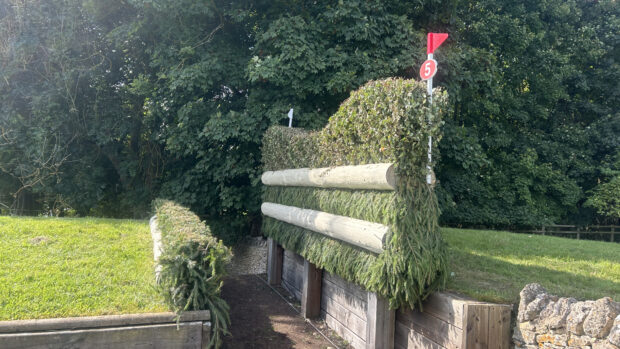Whether your horse is young or spooky with water there are several things you should bear in mind when training.
Before you start think about what the particular water jump you are training with looks like. Is the water murky? How deep is it? Horses can’t see where the ground is in a water jump so they have to learn to trust you implicitly in order to successfully negotiate such obstacles.
1. Slow and straight
Start in walk on a very straight approach where it is very clear to the horse that you want them to go into the water. Keep your reins wide so that you can channel your horse in a straight line into and through the water and your body sitting up so that you are in a secure position. Be ready to react to your horse’s behaviour with the water. If they are thinking backwards, keep your leg on to encourage them forwards, without hassling them too much — you need to give your horse time to read the question. Equally if your horse is trying to rush into the water without really thinking what they are doing or where they are putting their legs, try to steady them to a walk. You want their time with water to be a good experience so that you can build trust and reliability.
Continued below…
Looking to hone your skills with some schooling? How about these?
- Training with four-star event rider Caroline Moore in Shropshire
- Train with prolific eventer Jeanette Brakewell
- Attend a Tim Cheffings clinic in Devon
- Train in Essex over a cross-country course
2. Start small
To begin with walk into the water via a ramp as opposed to a step. It’s not fair to expect a horse to understand a drop and water in these early stages. Once in the water walk around in circles if possible to get the horse used to the feeling of moving around in it. Then walk out of the water again. Immediately turn around and walk back in again and repeat this process until your horse is happy, confident and not rushing or backing off from the task in hand. Remember to give your horse plenty of praise when they do as you ask. Once your horse is established at walking through water, introduce trot and canter under the same principles as walk.
3. Be patient
If your horse is taking a little longer than you would like to understand going into water, be patient. Try not to make a big issue out of it so that your horse doesn’t link water with being panicked and rushed. Don’t let your horse spook and turn away from the water — keep them in a straight line, with your leg on. The penny should eventually drop!
Continued below…
Want to put your schooling to the test? How about these competitions?
- Horse trials in Northumberland
- Go unaffiliated eventing in Dorset
- Try a mini one-day event in Norfolk
- Eventing in Somerset
- Go to a one-day event in Shropshire
4. Introducing obstacles
Once your horse is happily going in and out of the water via a ramp, you can introduce a small step. Be warned your horse is likely to react to this new question, and you should therefore be ready for them to back off and/or launch into the water. Start by walking up a small step. Once your horse is happily doing this without rushing or launching you can go down the same step. As your horse grows in confidence you can introduce other steps and jumps in and around water.
For more events and clinics visit Equo, Horse & Hound‘s online entry system




